The secret of ingredients
The secret of ramen
When noodles are served with soup and toppings in a single bowl we call this Ramen.
It is not an exaggeration to say that the best ramen comes simply by the balance between these three elements.
The secret of ingredients
Eggs
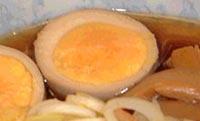
Eggs are an excellent food containing proteins, calcium, iron and other nutrients necessary for the human body. For this reason nutritionists called them "complete food". Such a nutritionally balanced and rich food is impossible to find elsewhere with the exception of milk.
In ramen, it is particularly effective in compensating the lack of protein as well for its mild sweetness that creates a perfect balance with the salt of the soup.
Eggs are an excellent ramen ingredient since ages and recently flavored boiled eggs are becoming very popular.
In Sapporo, are increasing restaurants in which you can choose your toppings with a self-service and shops where can be bought ramen toppings or exclusively flavored boiled eggs.
The reason for this boom is related to the popularity of Taiwanese style eggs boiled with tea that started to be served with ramen in Ogikubo ward, Tokyo, and then spread through the whole country.
There are various ways of making flavored boiled eggs, soy sauce eggs are both pickled and put them in a refrigerator for several hours to taste fresh as still boiled.
In any case, these eggs can be said an eye-catching decoration for each ramen bowl.
Nutritional value per 100g of edible portion.
(from the 4th revision of Japan standard food composition table)
| Nutritional component | unit | Chicken | Pork | Tuna | Milk |
|---|---|---|---|---|---|
| Protein | g | 12.3 | 17.0 | 28.3 | 2.9 |
| Lipid | g | 11.2 | 20.5 | 1.4 | 3.2 |
| Sugar | g | 0.9 | 0.4 | 0.1 | 4.5 |
| Calcium | mg | 55 | 5 | 5 | 100 |
| Phosphorus | mg | 200 | 147 | 280 | 90 |
| sodium | mg | 130 | 43 | 50 | 50 |
| Iron | mg | 1.8 | 1.1 | 2.0 | 0.1 |
| Vitamin A | IU | 640 | 23 | 20 | 110 |
| Vitamin B2 | mg | 0.48 | 0.23 | 0.09 | 0.15 |
Bean sprouts
Moyashi bean sprout can be said to be must ingredient for the traditional Sapporo miso ramen. Morito Omiya, the father of miso ramen, was the first to use bean sprouts as ingredient during the first half of the 50es. At that time Sapporo ramen ingredients were said to be simply menma pickled bamboo shoots, welsh onions and chashu roasted pork. All you had to do was to put them over the bowl before serving. However Omiya seemed to be not satisfied. He didn’t like to wait for the noodles to be ready without doing anything. So he started to stir bean sprouts in a fry pan in front of his costumers to make them hungrier. After that he put them on ramen to enrich its taste and served it.
From then on, many vegetables are fried while making ramen. Onions are the best but are also expensive; in addition their quality changes depending on the season.
Considering this, moyashi are preferred for this kind of preparation.Also, meeting the crispy consistence of bean sprouts Sapporo ramen noodles result more firm. At the moment, the moyashi bean sprouts generally used in Japan are a kind of "black gram" native to India, which is imported from Burma, Thailand and China. Although this sprouts have a sweet taste, they have the defect to be not enough thick and looking good, but now it is possible to make thicker moyashi with a low temperature long-term cultivation method.
Moyashi are said to have a high nutritional value because they take time to grow, as they also have a good diet and anti-blur effect. When used as a ramen ingredient, they also results excellent in reducing the smell of garlic.
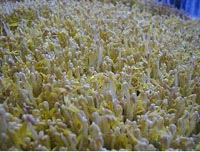
Black gram moyashi cultivated with long-term low temperature method. The point of making delicious sprout is "water". In this greenhouse, the water comes directly from Lake Shikotsu, 40 km south from Sapporo.
Photo courtesy Miki Food Co., Ltd.
Naruto surimi
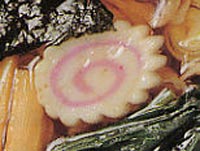
In old times outside of menma bamboo and chashu pork there was only one other ingredient for ramen. The naruto surimi with its spiral shape. In recent years, many ramen shops sadly started to put no more this ingredient on it. However this surimi is an important kin of authentic Japanese food called kamaboko Its history is old, and a description of it can be found in the book “Konyaku hyakuchin” (One hundred konyaku pastes) published in 1846.
Originally white fish caught from the Seto Inland Sea was used as main ingredient. It was swirled into a surimi which was then dyed red, with a dipstick, in a spiral shape that resembles the whirlpools of Naruto Strait. That`s the reason for its name "Naruto". At present, the largest production area for this surimi is located in Yaizu City, Shizuoka Prefecture, where is produced the 90% of the Naruto surimi consumed in whole Japan.
In Yaizu the production sets back to the end of the Taisho Era (1912-1926). It was from the early Showa era (1926-1989) when ramen became widespread through Japan that naruto surimi success began. This led to mass production through the development of rolling machines.
The principal function of Naruto surimi in ramen seems to be merely aesthetic. It may be said that Naruto surimi helps to give an accent to ramen taste and color.
Welsh onion
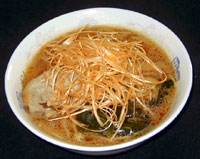
Nebuka-type welsh onion miso ramen is one of the most popular ramen variety in Sapporo
Along with menma bamboo and chashu pork one of the essential ingredients for noodles is welsh onion. With the development of distribution services, vegetables of the same variety were spread widely throughout the country but welsh onions were still among the few vegetables that maintain their uniqueness by region.
Thin and entirely green welsh onions are often used in Kansai and Kyushu, and thus referred as "green onions”. Typical examples are Kujo green onions in Kyoto and Hakata green onions in Fukuoka. Their sweetness and fragrant consistency matches perfectly the rich taste and smell of the soup.
On the other hand, in Kanto region, welsh onions feature a white large and thick stem. Fukaya welsh onions of Saitama, has a sweet taste and a crispy consistence matching perfectly for soy sauce ramen, popular throughout the Kanto area.
The peculiar flavor of welsh onions fade very easily so it`s better to chop them just before the noodles are boiled and the ramen bowl can be served. It is ideal to put chopped fresh welsh onion directly in the bowl with tare sauce before pouring the hot sauce over it. However, there may be only few restaurants that do this way.
As for the effect of green onion, allicin (a kind of allyl sulfide) is a pungent ingredient, which stimulates the gastrointestinal tract, promotes the secretion of digestive fluid and stimulates the appetite. It is also promotes the absorption of vitamin B1 and is said to have an effect on fatigue recovery.
Types and features of welsh onions
| Type | Commercial name | feature |
|---|---|---|
| Senju type | Fukaya welsh onion | Thick onion and soft stems are produced around Fukaya City, Saitama Prefecture. |
| Kincho welsh onion | The most popular type of white stem welsh onion because resistant to diseases, easy to make and looking good. | |
| Kaga type | Shimonita welsh onion | Special product of Shimonita-cho, Gunma Prefecture with a unique wide a shape. With its sweet taste is often used for nabe hot-pots dishes. |
| Iwasaki welsh onion | Cultivate in Iwasaki City, Saitama Prefecture, a rare totally green welsh onion in the Kanto area. | |
| Koshizu welsh onion | Grown in Tsushima City, Aichi Prefecture. | |
| Kujo type | Kujo welsh onion | The nationwide famous green welsh onion from Kyoto area. There both thin and large variety. |
| Banno welsh onion | Kujo type green onions cultivated in Hakata area, near Fukuoka. | |
| Others | Asatsuki welsh onion | A variety very similar to onions with a strong taste but soft smell. |
| Wakegi welsh onion | Distinctive smell is similar to green onion but in botanical terms, another species |
Spinach
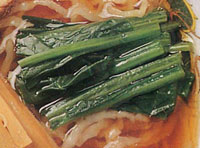
Spinach are said to have been originated in Iran (formerly Persia). In Japan, they were first introduced from China under the name of "Takanana" in the 1631 as reported in documentary records.
Spinach were divided into two varieties: oriental species featuring red roots, narrow leaves and cuts deep sowed in autumn and western species sewed in spring with round and thick leaves sewed in spring. In recent years, hybrid species that has the thickness of the westerns but the taste of the oriental ones have become popular throughout the year.
Spinach, which are not generally used as a ramen ingredient, are instead a very nutritionally excellent vegetable rich in vitamins A, B1, B2, C containing an high amount of iron very important for blood. For this reason are considered a good food with a preventive effect for anemic people. In addition the color of the appearance is good and its taste matches perfectly with soy sauce soup. In ramen, which tends to run short of vegetables, spinach stands as a vegetal ingredient that once tried, you cannot avoid to try it again
Chashu roasted pork stew
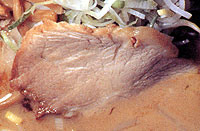
Among the ingredients for a good ramen, chashu pork is an essential one. In the past, it was often the standard for choosing ramen restaurants and even today is the most popular among the ramen ingredients.
Chashu means “grilled” and originally was one of the traditional pork recipes in China consisting in seasoned low-fat pork thighs with plenty of red sauce, called hong-shao, and then carefully grilled in a specially-made oven.
Another method similar to this consisted in grill three slices of pork meat inside a special oven seasoning it with salt and peppers instead of hong-shao red sauce resulting in a more grassy meat rather the previous one.
However nowadays there are almost no ramen restaurants that make chashu with the mentioned cooking methods. Most of them are made by tying pork belly meat, thigh and shoulder with kitchen wire, and simmering them with soy sauce-based sauce seasoned with only salt and pepper. With this cooking method there will be “roasted pork" instead of “grilled pork”.
In Sapporo many ramen shops prepare miso ramen with minced meat instead of pork. The combination of miso and minced meat matches surprisingly. Minced meat is used in place of chashu in "Ami no Sanpei" restaurant, the birthplace of miso ramen.
Finally let`s take a closer look to the meat parts necessary to prepare chashu
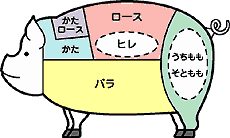
-
Shoulder
Difficult to prepare because easy to overcook and to lose its taste. But savory and soft in the mouth.
-
Outer leg
Hard to overcook while the taste soaks well. When cooked is relatively solid.
-
Inner leg
The taste is relatively easy to soak in and it is hard to get lost because is intermediate nature between shoulder ad outern leg. When cooked is soft, though not as much as shoulder.
-
Belly
Red meat and fat are together so it will be hard to get overcooked. If the fat is part is outside it will melt into mouth once cooked.
Menma pickled bamboo sprouts
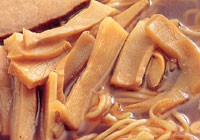
Menma bamboo can be said to be the second indispensable ingredient for ramen.
menma is made from machiku, a kind of bamboo that can be found in China and Taiwan, where is called sungan. Originally Taiwan and China have a large bamboo production with 200 to 300 types of bamboo among which there machiku figures. However, bamboo shoots that are commonly eaten in Japan come from moso bamboo.
In the Meiji era (1868-1912) many of the Chinese living in Yokohama Chinatown, considered the birthplace of ramen, were from Fujian and Guangdong provinces in China. These regions were plenty of machiku bamboo, and home-made dishes, like bamboo sprouts boiled with pork to take the umami from meat, were very popular.
When in Japan these sprouts started to be eaten in ramen they became a “must have” ingredient. But how these essential menma pickled bamboo sprouts are produced in Japan? First of all, it all starts with the method of harvesting machiku bamboo sprouts. Differently from Japanese bamboo shoots it does not dig in the ground, but it grows up to 60 to 70 cm in length and 15 cm in diameter. After cutting it, peeling it and cutting off the top and bottom, the remaining central part is chopped into pieces and simmered for about an hour. Next, it is put it in a basket and buried in the soil for 1 month to naturally ferment. The fermented machiku bamboo is then taken out of the basket, dried in the sun, soaked in salt water, dried in the sun again, and then dried with synthetic wind inside a factory. Because this long necessary preparation in Japan, the dried menma bamboo sprouts result mainly imported
